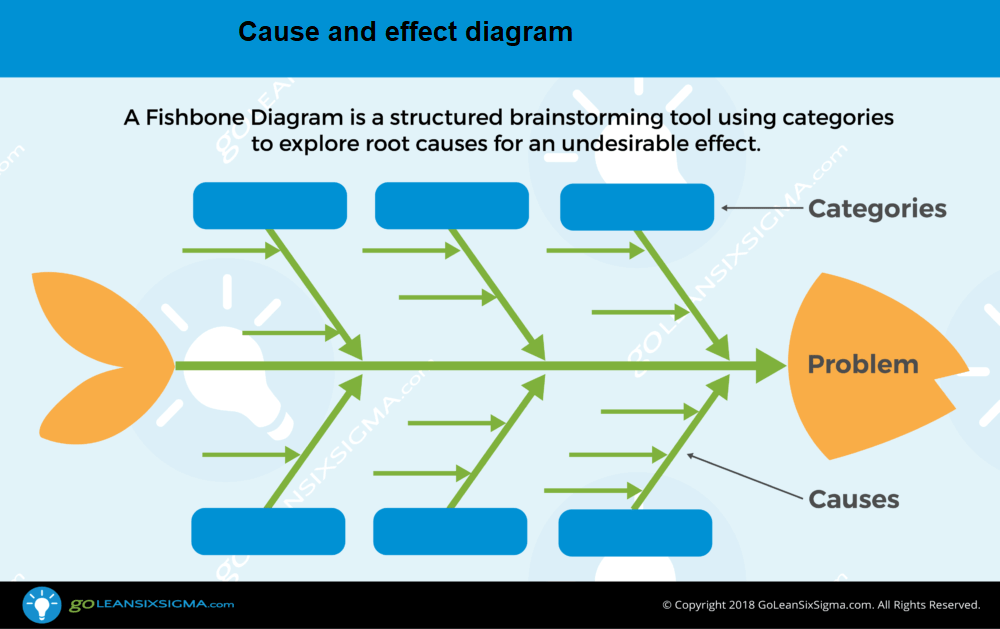Cause and Effect Diagram Homework Help
Cause and Effect Diagram
There are various efficiency and the board devices utilized in business associations. Circumstances and logical results Diagram, as such, Ishikawa or Fishbone graph, is one such administration device. Because of the fame of this device, dominant part of supervisors utilizes this device paying little mind to the size of the association.
Steps for Using the Tool
Following are the means that can be pursued to effectively draw a circumstances and logical results graph:

Stage 1 - Properly recognize the issue close by
Begin articulating the accurate issue you are confronting. Here and there, distinguishing proof of the issue may not be direct. In such cases, record every one of the impacts and perceptions in detail. A short meeting to generate new ideas might almost certainly call attention to t the genuine issue.
With regards to appropriately distinguishing the issue, there are four properties to consider; who are included, what the issue is, the point at which it happens, and where it happens. Record the issue in a case, which is situated at the left-hand corner (allude the model circumstances and logical results graph). From the container, attract a line evenly to the correct hand side. The course of action will presently resemble the head and the spine of a fish.
Stage 2 - Add the central point that add to the issue
In this progression, the fundamental variables of the issue are recognized. For each factor, draw off a line from the fish's spine and appropriately name it. These variables can be different things, for example, individuals, material, hardware or outside impacts.
Think more and include the same number of as variables into the circumstances and logical results outline.
Conceptualizing turns out to be very valuable in this stage, as individuals can take a gander at the issue in various points and recognize diverse contributing variables.
The elements you included presently become the bones of the fish.
Stage 3 - Identify the causes
Take one factor when distinguishing potential causes. Conceptualize and attempt to recognize all causes that apply to each factor. Include these causes on a level plane off from the fish bones and mark them. In the event that the reason is huge in size or complex in nature, you can advance breakdown and add them as sub causes to the fundamental driver. These sub causes should fall off from the important reason lines. Invest more energy in this progression; the gathering of causes should be complete.
Stage 4 - Diagram investigation
At the point when this progression begins, you have a chart that demonstrates the issue, the contributing variables, and every conceivable reason for the issue. Contingent upon the conceptualizing thoughts and nature of the issue, you would now be able to organize the causes and search for the no doubt cause. This examination may prompt further exercises, for example, examinations, meets and overviews. Allude the accompanying example circumstances and logical results outline:
Cause and effect diagrams
With regards to the utilization of circumstances and logical results graphs, conceptualizing is a basic advance. Without legitimate conceptualizing, a productive circumstances and logical results outline can't be inferred. In this manner, following contemplations ought to be tended to during the time spent determining a circumstances and logical results graph: There ought to be an issue articulation that portrays the issue precisely. Everybody in the meeting to generate new ideas ought to concur on the issue proclamation. Should be brief all the while. For every hub, think all the potential causes and include them into the tree. Associate every loss line back to its underlying driver. Interface generally void branches to other people. In the event that a branch is excessively massive, think about part it in two.
Project Management Tutorials
- Activity Based Costing
- Basic Quality Tools
- Benchmarking Process
- Cause and Effect Diagram
- Project Activity Diagram
- Project Charter
- Project Contract Types
- Project Cost Control
- Gantt Chart Tool
- PERT Estimation Technique
- Work Breakdown Structure
- Motivational Theories
- Project Kick-off Meeting
- Conflict Management
- Crisis Management
- Critical Chain Project Management
- Decision Making Process
- Monte Carlo Analysis
- Negotiation Skills
- Pareto Chart Tool
- Project Management Processes
- Project Manager Goals
- Project Portfolio Management
- Project Quality Plan
- Project Scope
- Project Management Software
- Project Time Management
- Capability Maturity Model (CMM)
- Critical Chain Project Management (CCPM)
- Critical Path Method (CPM)
- Earned Value Management (EVM)
- Enterprise modeling
- Event chain diagram
- Five Forces Analysis
- Graphical Evaluation and Review Technique (GERT)
- Inclusive Management
- Product Life Cycle
- Run chart
- Six Sigma
- Aggregate planning
- Budgeted Cost of Work Performed
- Business analysis
- Business Process Modeling (BPM)
- Event Chain Diagrams
- Gantt chart
- Henry Gantt
Project Management Case studies
- Project Management Methodologies
- Implementation of Project Management
- Project Management Cultures
- Project Management Organizational Structures
- Negotiating for resources In Project Management
- Project Management Estimating
- Project Management Planning
- Project Scheduling
- Project Execution
- Controlling Projects Case Study
- Project Risk Management
- Conflict management Case Study
- Morality and Ethics Case Study
- Managing Scope Changes Case Study
- Wage and Salary Administration
- Time Management Case Study
- Industry Specific Construction Case Study
Project Management Sample Assignments
Project Management Sample Solutions
Testimonials
Very affordable projects!! And that to submit before deadlines. Thanks for helping me in my database project and raising my grades. I have been able to secure good marks in my internal assessment only because of you. Read More

